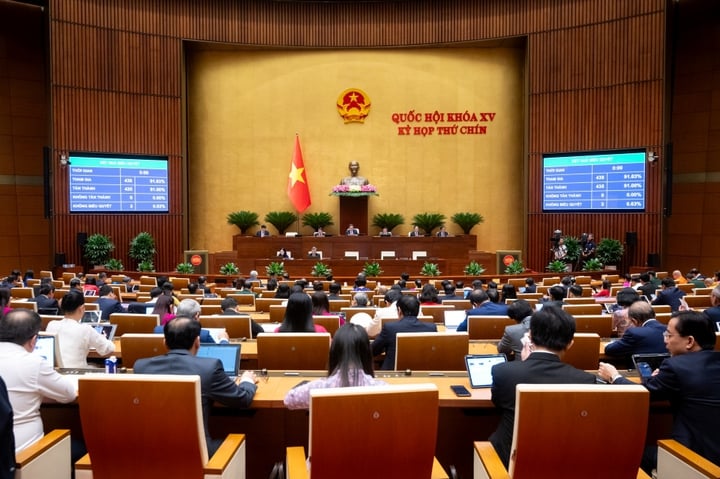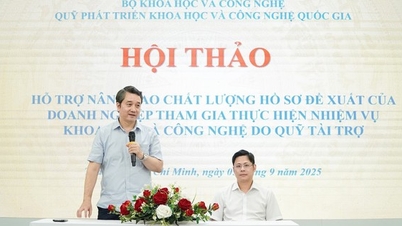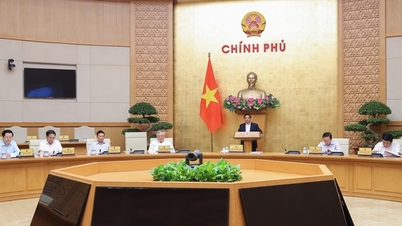On the morning of June 27, 2025, the National Assembly officially passed the Law on Science , Technology and Innovation (S&I), marking an important institutional turning point in the management thinking and shaping of the national S&T and innovation development ecosystem.
This is the result of a process of summarizing practices, absorbing thousands of opinions and selectively inheriting the achievements of the 2013 Law on Science and Technology. If the 2013 Law is the foundation for the accumulation period, the 2025 Law on Science, Technology and Innovation is the springboard for the breakthrough period, where knowledge and innovation become the "strategic resources" of the country.

The 9th session of the 15th National Assembly passed the Law on Science, Technology and Innovation.
The Law on Science, Technology and Innovation is built closely following the guiding viewpoints in Resolution No. 57-NQ/TW, while also absorbing major policies from Resolutions 66 and 68 of the Politburo and Resolution 193/2025/QH15 of the National Assembly.
The Law has redesigned the entire content structure towards integrating key elements of national development in the digital age: developing science and technology enterprises, digital transformation, promoting international cooperation, improving research ethics, commercializing research results and protecting intellectual property rights.
Innovation is fully legalized
One of the biggest breakthroughs is that for the first time, innovation has been comprehensively legalized as an independent component, placed on par with science and technology, demonstrating a fundamental change in development thinking. This is a breakthrough that demonstrates a strong shift from management thinking to creation thinking, from support to leadership - empowering creative subjects, especially businesses.
Emphasizing innovation also emphasizes the role of promoting the application of science and technology in practice, contributing to increasing the value and efficiency of the economy and society. If science, technology and innovation are expected to contribute 4% to GDP growth, the contribution from innovation accounts for 3%, while science and technology accounts for 1%, thereby clearly reflecting the widespread, practical and universal role of innovation in the modern economy.
In addition, the Law also establishes an official legal corridor for the innovative startup ecosystem, which is a step forward in institutionalizing the spirit of Resolution 57-NQ/TW and national policies on innovative startups. Concepts such as innovative startups, startup promotion organizations, venture capital funds, technology exchanges, etc. are clearly defined for the first time in the Law. This allows entities in the startup ecosystem to operate transparently, have mechanisms to protect their rights, access incentives and state resources legally, and at the same time create conditions for the models of "startup universities", "applied research institutes" to develop strongly, etc.
The Law also expands the rights of non-public organizations to have equal access to state policies and resources; allows individuals to contribute capital to establish science and technology organizations. The public-private-institute-school linkage is strongly promoted, overcoming administrative barriers in the 2013 Law.
Enterprises play a central role, the science and technology organization system is restructured.
The law establishes enterprises as the center of the national innovation ecosystem. Enterprises are not only beneficiaries but also creators, owners and commercializers of research results. Enterprises are granted ownership of research results without prior valuation, are exempted from income tax on innovation activities, and receive strong incentives in terms of land, credit, human resources and finance when investing in research and development (R&D).
In particular, the Law allows businesses to participate in sandboxes - a controlled testing mechanism for new technologies. Sandboxes in the Law on Science, Technology and Innovation are not only applied to the financial sector as before, but are expanded to include emerging technologies such as AI, Fintech, GovTech, EdTech, biotechnology, big data, etc. The Law requires the Government to issue a set of common principles on sandboxes, ensuring consistency and avoiding fragmentation and institutional fragmentation as at present.
The law also reshapes the system of scientific and technological organizations towards streamlining and transparency. Registration of scientific and technological activities only applies to research and development organizations. Public organizations will be evaluated based on output efficiency, with clear funding or dissolution mechanisms, creating pressure for innovation and increasing accountability.

The law allows businesses to participate in sandboxes - controlled testing mechanisms for new technologies.
Financial Institutional Reform: Delegation - Accompanying - Post-auditing
Regarding the financial mechanism, the Law on Science, Technology and Innovation 2025 has undergone a radical reform. Instead of maintaining the traditional administrative funding method, the Law has shifted to a funding mechanism based on results and objectives. New regulations such as exempting bidding for the lump sum funding, assigning ownership of research results to the host organization, and allowing flexible use of the science and technology development fund are breakthrough changes.
The law also focuses on promoting socialization and mobilizing resources from the private sector. The mechanism of co-funding, counterpart funding, and funding in the form of contracts between the State and enterprises is legalized, creating conditions for scientific research to no longer be a burden on the budget, but become a strategic investment opportunity.
At the same time, the Law significantly reduces administrative procedures and increases the rate of post-inspection, instead of the dense pre-inspection as before. This change clearly demonstrates the transformation of management thinking from "process control" to "result control", from control to creation, from "ask - give" to "delegate - evaluate", in line with international practices, promoting innovation and reducing legal barriers to scientific activities.
Protecting scientific integrity, accepting risks in research
The Law on Science, Technology and Innovation 2025 has a separate provision to regulate scientific integrity and professional ethics, considering this the ethical and legal pillar of the research ecosystem. Acts such as falsification, data distortion, plagiarism, concealment of conflicts of interest, and distortion of the nature of research... are identified as serious violations. For the first time, the management agency is responsible for guiding the implementation, handling and updating violations on the national digital platform for science, technology and innovation. This is not only a step forward in academic ethics, but also a stepping stone to building social trust in research results.
One of the notable new contents of the Law is the clear regulation on risk acceptance in scientific research, technology development and innovation. Accordingly, organizations and individuals performing tasks that have fully complied with the procedures and regulations and have not committed any fraudulent acts, violated the law or misused the objectives or scope of funds will be exempted from administrative and civil liability when causing damage to the State. At the same time, they will not have to repay the funds if the results do not achieve the set objectives, provided that they have complied with the regulations on task management, research content and risk prevention measures. Similarly, those who approve and manage tasks using the State budget are also exempted from liability if they have not violated the law and have followed the correct procedures.
In particular, the Law stipulates the exclusion of criminal liability under the Penal Code for risks occurring in the process of research, testing, and application of scientific, technical, and technological advances. The Government will specify this in detail, including criteria for determining acceptable risks and procedures for assessing compliance with procedures and legal regulations.
This helps scientists "dare to think - dare to do - dare to take responsibility", promoting real breakthroughs instead of avoiding high-risk but high-value areas. At the same time, the Law requires the establishment of a systematic risk management mechanism to control consequences.
Controlled Testing: Legalizing a Sandbox for Emerging Technologies
Law 2025 devotes a separate section to regulations on controlled testing, establishing for the first time a legal mechanism for the "sandbox" model that has become popular in many countries. Accordingly, organizations and businesses can propose testing new technologies, processes, and business models (AI, blockchain, fintech, etc.) that are not regulated by current laws.
Testing must take place within the limits of time, space, and subjects and must meet the principles of transparency, fairness, consumer protection, and social safety.
In particular, the Law provides a mechanism for excluding liability for parties participating in the trial if they have fully complied with the process, have not violated the law, and have not concealed risks. This creates a "legal safety zone" for breakthrough ideas to be tested in a real but controlled environment.
This is an unprecedented step in the 2013 Law, which did not have any provisions on technology testing or innovation policy.
Giving ownership of research results: From "asking - giving" to "self-determination - companionship"
A major bottleneck in practice over the past 10 years has been the delay in commercializing research results due to problems with ownership, pricing, benefit sharing, etc., which the 2013 Law has not been able to completely resolve.
Law 2025 grants automatic ownership of research results and assets formed from tasks using the state budget to the host organization, without approval procedures, without having to repay the budget or record an increase in state capital. At the same time, the host organization has full rights to commercialize and choose the form of exploitation such as: sale, lease, capital contribution, joint venture, etc.
In particular, the Law stipulates: Authors are entitled to receive at least 30% of the profits from commercialization. For the first time, a mandatory bonus is stipulated, instead of "incentives" as in the 2013 Law, which creates a practical motivation for scientists to stick with the product and the market, instead of just stopping at academic publications.

Center for Nano and Energy, University of Science, Vietnam National University, Hanoi, where training and research on semiconductors.
In the context of the rapid global shift to digital economy, green economy and creative economy, the promulgation of the Law on Science, Technology and Innovation is a strategic step for Vietnam. The Law not only inherits the achievements of the 2013 Law on Science and Technology but also paves the way for a new stage of development - where knowledge, technology and innovation become the decisive resources of the country. This Law is the "institutional launch pad" for Vietnam to enter a new, more sustainable and breakthrough stage of development.
With this new legal framework, businesses will have more motivation to innovate, institutes and schools will have more autonomy, scientists will have more space to innovate, and the Government will have more tools to effectively regulate the knowledge economy. The Law on Science, Technology and Innovation is therefore the law of the future - the law of creativity.
Source: https://mst.gov.vn/luat-khcndmst-kien-tao-he-sinh-thai-tri-thuc-dan-dat-doi-moi-quoc-gia-197250627122226568.htm





![[Photo] Amazing total lunar eclipse in many places around the world](https://vphoto.vietnam.vn/thumb/1200x675/vietnam/resource/IMAGE/2025/9/8/7f695f794f1849639ff82b64909a6e3d)





























































![[Photo] General Secretary To Lam chaired the Politburo's working session with the Standing Committee of the Central Public Security Party Committee](https://vphoto.vietnam.vn/thumb/402x226/vietnam/resource/IMAGE/2025/9/8/c94b4e255b194b939a1c7301893f5447)




























Comment (0)